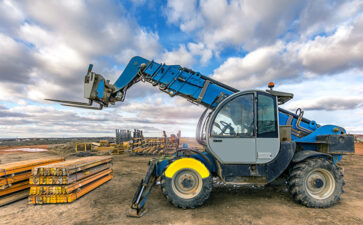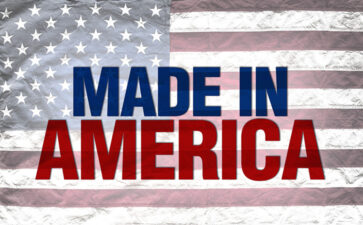Carlisle TyrFil Technology Helps Defray Construction Vehicle Costs during Times of Inflation
Greater inflation is definitely upon us, as evidenced by recent fluctuations in the U.S. economy and housing market. The current inflationary situation can be attributed to a number of factors—everything from the supply chain back-up and chip shortage, to the global Covid-19 pandemic and conflict in Ukraine. According to the Wall Street Journal, “U.S. inflation accelerated to a 9.1% annual rate in June, its fastest pace in nearly 41 years.” And in recent months, American consumers have faced a plethora of shortages and price changes on everything from the cost of meat and eggs, to the price of gasoline, used cars, furniture, vacation travel, coffee, and more.
According to Investopedia, inflation is “a measure of the ratio of rising prices of goods and services in an economy”—with inflation conditions occurring when “prices rise due to increases in production costs, such as raw materials and wages.” Simply put: This type of economic scenario is driven by heightened demand colliding with increasingly limited supplies—and, right now, we’re entering the perfect storm.
While a number of industries across the U.S. have been impacted by the above conditions, the construction industry has been handed an especially strong dose of “inflation impact.” Construction is a market space that is highly reliant on a wide breadth of supplies and integrated operations. It’s one of many industries that rely both on multiple supply chain resources and on large manpower volume to cohesively operate. According to TheConstructor.org, “Inflation is a major challenge for the construction industry as it leads to an increase in the prices of building materials, hiring rates of machinery, consultation fees, and other inputs to construction projects. As a result, it may delay project completion, increase construction costs, and reduce profit margin.” Central to increased construction workplace and project costs is the price of materials needed to complete the job—whether it’s for a commercial or residential-type of build. Manpower and increasing wages are two other big concerns, along with operational costs and energy use.
Another key aspect of construction project management that has been impacted by current price hikes and inflation conditions is the cost of transportation. According to TheConstructor.org, “…higher energy prices mean higher transportation costs of materials and equipment and higher costs for rented machinery. Manufacturers of construction equipment commonly increase the cost because of an increase in the cost of raw materials and delay in production due to inflation. This reduces the profitability of the entire project.”
While many elements of current transportation-related pricing may be out of the typical jobsite manager’s control, there are ways that operators can mitigate some of the uncertainty around escalating equipment and vehicle expenses. Specially, the choice of tire technology plays a major role in the cost-efficiency of construction equipment operations. Why? For example, heavy Off-the-Road (“OTR”) vehicles are largely dependent on ensuring that the tires that support this heavy workhorse machinery—such as bulldozers, excavators, skid steer loaders, forklifts, dump trucks and trenchers—are in proper working order. Afterall, a piece of OTR equipment is only effective if the tires it’s riding upon remain flat free at all times.
Carlisle TyrFil polyurethane “foam” fill enables large commercial vehicles that are the backbone of any successful construction site to successfully operate over common debris—such as sharp rocks, nails, broken glass and rebar—without incurring unwanted tire flats or punctures. Why is this important? First, and foremost, damage to OTR vehicles tires can be extremely dangerous. A sudden tire flat on a large piece of earthmoving equipment can potentially lead to serious driver injury, especially if the vehicle is operating on a hillside or on an uneven gradient. Unexpected tire flats also are costly to repair and render a potentially pivotal piece of transportation equipment virtually unusable for the near future. This is a cost that already fiscally constrained transportation managers definitely don’t want to grapple with—especially during periods of economic inflation that are already tightening budgets and squeezing project dollars.
By switching to TyrFil “foam fill” tires (versus solid apertures), operators can save time, money and headaches on the job, not to mention ensuring better onsite worker safety and productivity—all while lowering the risk of liability. TyrFil is a safe alternative to solid aperture tires, which are heavy, expensive and deliver a bumpy, jarring ride. Drivers who operate vehicles outfitted with solid tires are vulnerable to the jolting from continuous G-force and cross axle vibration on the driver’s seat. This condition, known as Whole Body Vibration, or WBV, may create muscular/skeletal strain on equipment operators who often spend 8 or more hours per day behind the wheel.
TyrFil also delivers a more ecologically beneficial option for construction entities and developers looking to lower carbon footprint emissions. The use of polyurethane “foam” fill helps to extend the lifecycle of the tire carcass—allowing tires to be retreaded and repurposed for “second life” use—helping to prevent more tire carcasses from going into our environment’s already overcrowded landfills. Most importantly, the use of TyrFil saves operators valuable resources, while also maintaining safer operations. That’s something that our industry can welcome in 2022 when our nation is already facing economic pressures that are taxing the construction and real estate development industry’s bottom-line.
For more information on tire flatproofing technology options and benefits, please visit Carlisle TyrFil FlatProofing.
Read related news: Benefits of TyrFil’s Improved Tire Performance and Longer Life Expectancy


